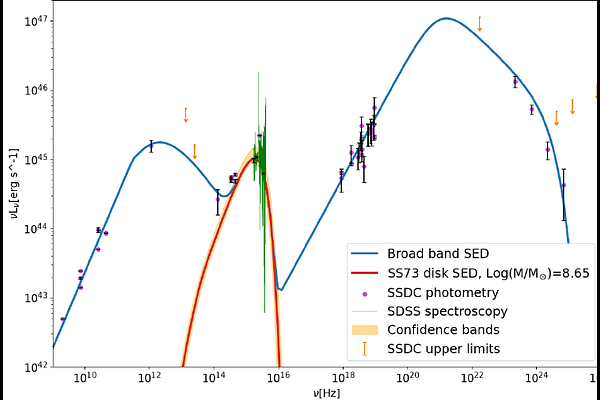NVSS J151002+570243: accretion and spin of a z > 4 Fermi detected blazar

NVSS J151002+570243: accretion and spin of a z > 4 Fermi detected blazar
Gabriele Alzati, Tullia Sbarrato, Gabriele Ghisellini
AbstractActive galactic nuclei formation and evolution is currently an open puzzle. Their enormous mass is not explainable via sub-Eddington accretion and the frequent presence of relativistic jets at high-z, commonly linked with spinning black holes, suggest a less effective accretion process. NVSS J151002+570243 is part of this population, being the most distant blazar consistently detected by Fermi/LAT, hence hosting a powerful jet. We tested the hypothesis of a super-Eddington accretion process for this source by modeling its big blue bump with a set of accretion disk emission models. We first tested a standard geometrically thin, optically thick $\alpha$-disk, obtaining a mass of Log$M/M_\odot=8.65\pm0.19$ consistent with virial-based results and a significantly sub-Eddington accretion rate $\lambda=0.02\pm0.01$. We then focused on the analytic approximations of two numerical models that take into account the General Relativity effects of a spinning black hole (reasonable due to the presence of a jet) and a close-to- or super-Eddington accretion rate (KERBB and SLIMBH). Despite the focus on super-critical accretion, these models confirm a surprisingly low Eddington ratio, of the order of 3\%. The hypothesis of a continuous accretion at this measured rate is unrealistic, since it would imply a seed black hole mass of $\sim10^6-10^8M_\odot$ at redshift z=20. Hence we explore the possibility of a continuous super-critical accretion starting from a $\sim10^2M_\odot$ seed, that would spin up the black hole and eventually contribute in launching the relativistic jet. The measured low accretion rate would thus happen only once the jet is active. This idea would reconcile the black holes with large masses accreting at somewhat slow rates that are observed at z>4, with the need of an extremely fast evolution, by allowing the formation of stellar-size black hole seeds even as late as at $z\sim8$.